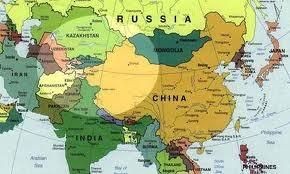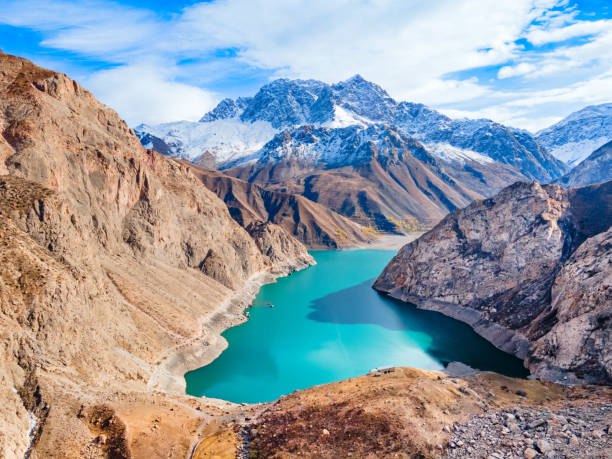LONDON (TCA) — China, and to lesser extents Russia, have been unloading coffers full of billions to spread their wings over Central Asia. The par value of the assets which have been taken by the generous-looking fund providers has changed dramatically and regretfully for the worse. That there can be no investments without returns is something the Chinese have known from the start, the Russians are realising that right now, and Central Asian states would realise that soon.
According to an agreement inked back in late 2012, Russia got financially involved in two major-size hydro-projects in Kyrgyzstan. The idea was that such projects should have been completed before the end of the current decade with the first one to be ready into operation this very year. The Upper Naryn Cascade, estimated to cost $734 million, and with a design capacity of close to 1,000 Megawatt, should be enough to secure sufficient power supplies to the entire east and south of Kyrgyzstan and leave considerable amounts for export. The second one, known as the Kambarata-1 project, has a design capacity of 2,000 Megawatt and a price tag of around $2.5 billion, and is also located on the Naryn river. It could also serve the relatively densely populated and industrialized central north of Kyrgyzstan and deliver additional supplies to the second-largest population and economic zone in the southwest. Eventual surplus output could be added to exportation.
‘Subject to negotiation’
For exports to China, a direct link across the border into the autonomous province of Xinjiang, which borders Kyrgyzstan, will be sufficient. To reach Pakistan, there are two hubs to be taken. The first is another mega-generation project in the region, the Rogun dam on the river Vakhsh in the central-west of Tajikistan, with a design capacity more or less equal to that of Kambarata-1 but less determined construction price depending on various estimates. Construction started in the 1980s but was put on halt in 1993 after the outbreak of the Tajik Civil War.
The Rogun dam is supposed to keep the capacity of 1,000 Megawatt for export to Pakistan and India, with another 300 MW to be added by Kyrgyzstan. Financing also remains “subject to negotiation”. Exportation towards the south would take place through a trunk line known as CASA-1000, a $1-billion-plus link leading over a distance of 750 km from Rogun, with a side branch from Kyrgyzstan, from Tajikistan into Pakistan crossing a narrow strip of Afghan territory. Both Daesh (ISIL) and the Taliban are active in the area.
Liability shifted
Taken all that together even when excluding the security factor, the entire scheme can only make the Kyrgyz and Tajik projects profitable if the FOB sales price for the bulk of the electricity — meaning domestic and external sales combined — is in the order of 10 dollar cent per kilowatt hour, experts on the Russian side calculated – a bit late for all it matters. Instead of risk-bearing investment, the Kyrgyz side has therefore been offered a loan by Russia at an interest rate of around 10 per cent – more or less covering the net income margin on sales. It means that the liability in the venture would be shifted from Russia to Kyrgyzstan. That is something no Kyrgyz parliament would ever accept, and as a result Kyrgyzstan denounced the hydro-power agreements with Russia earlier this month.
In both cases, one can imagine Russian state executives scratching behind their ears while thinking aloud: why do we need to spend multi-billion dollar amounts to build super-capacity hydropower dams and generators in Kyrgyzstan and Tajikistan in order for them to get free or cheap power at home and sell the rest to China, India and Pakistan? The obvious answer is that they just don’t. If the three and eventually other end-users of Central Asia’s power-glut want to see their supplies secured, let them invest…
Secured with collateral
With Russia only now getting economical driven by cash constraints at home, China has shown to have a much more balanced next-door investment policy – and also a much tougher one for all it matters – from the very beginning. As of the end of 2014, China was only the fourth biggest Asian investor in the Russian economy, having made cumulative direct investment of about $3.37 billion. Japan had invested $14.4 billion in Russia, while India had invested $3.6 billion and Turkey about $5.7 billion. On top of the list of beneficiaries of Chinese investment capital was Kazakhstan with $23.6 billion. The other four Central-Asian former Soviet republics have accumulated in the order of $14 billion altogether.
But China has always taken care that the cash it provides is secured with collateral worth its lump sum and preferably a little more. Thus, China’s investments in Kazakhstan’s oil fields and transportation facilities are secured in oil and gas – not in cash. Every time the oil price slumps, the Chinese party is simply entitled to more oil. The same is true for Turkmenistan’s gas sector.
In sectors where there is no such hard collateral, cash is required from China’s Central-Asian partners – after all, a partner is not called a partner for nothing. Thus, Kazakhstan sees itself forced to raise close to 3 billion greenbacks this year and another 20 billion in a few years to come in order to contribute to the New Silk route. According to news reports, the money will have to come from the national reserve fund Samruk-Kazyna. But that fund is already overburdened with demands to fill up a long list of gaps in all kinds of state budgets.
It comes down to the plain fact that Central Asia’s former Soviet states will be able, if they play it cool, to reap some benefits of China’s westward-ho aspirations – but they will always remain instrumental in the game and never indispensable. Russia is now learning that from its celestial neighbor, in such a hard way that Russians are unlikely to forget the lesson soon. To be truly independent with dignified living standards, Central Asia’s republics will have to do a lot more and that lot can only be found at home.









